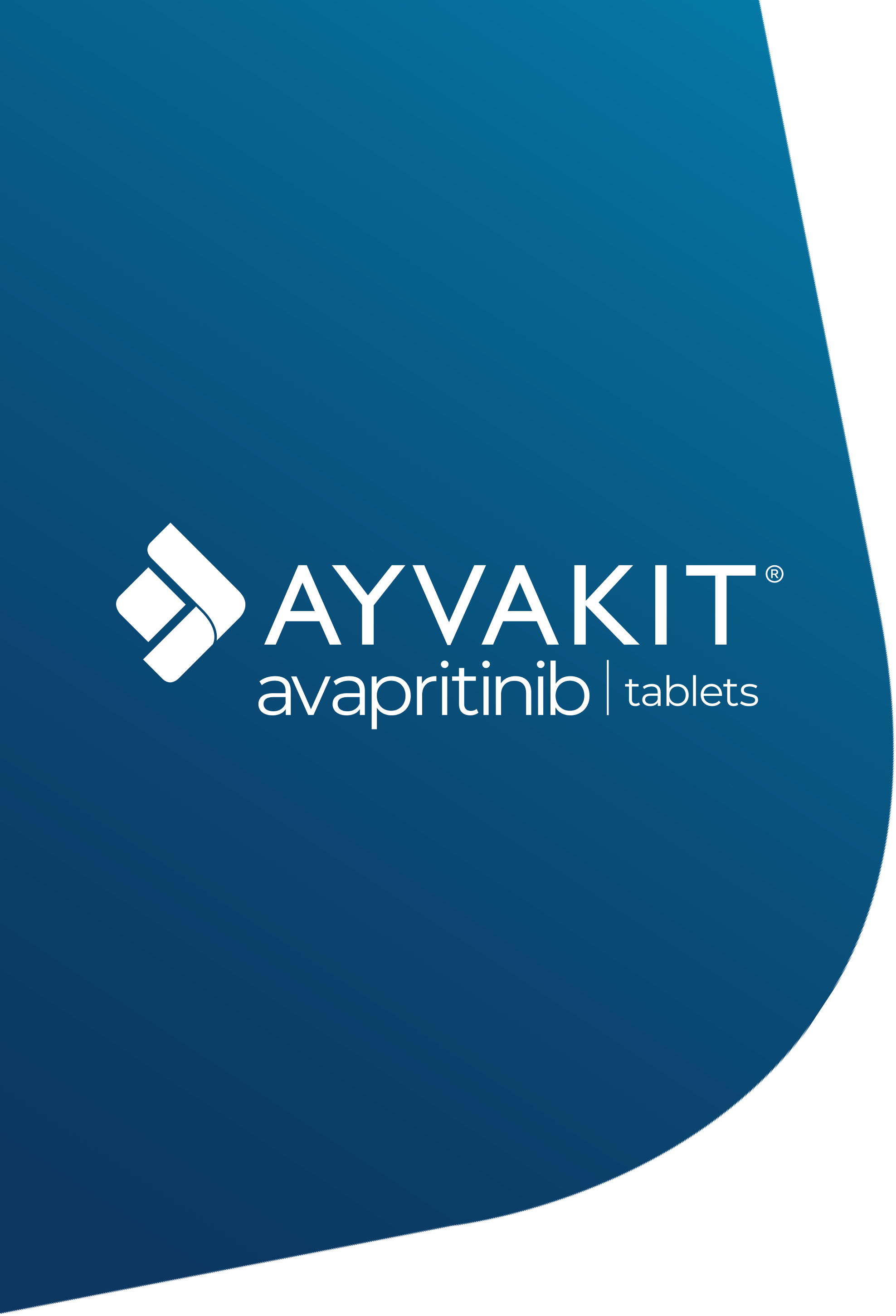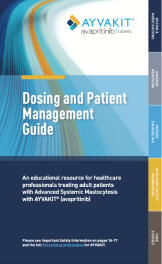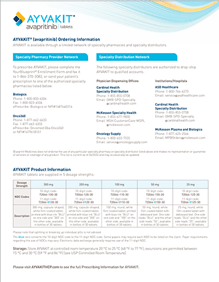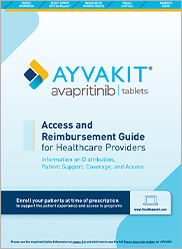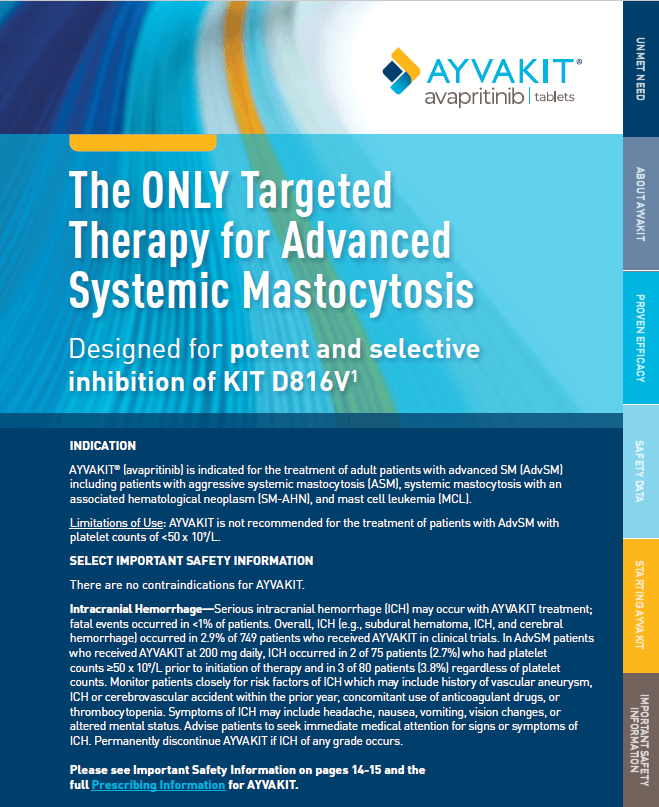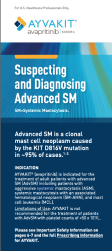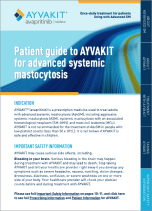INDICATION
AYVAKIT® (avapritinib) is indicated for the treatment of adult patients with advanced SM (AdvSM) including patients with aggressive systemic mastocytosis (ASM), systemic mastocytosis with an associated hematological neoplasm (SM-AHN), and mast cell leukemia (MCL).
Limitations of Use: AYVAKIT is not recommended for the treatment of patients with AdvSM with platelet counts of <50 x 109/L.
IMPORTANT SAFETY INFORMATION
INDICATION & IMPORTANT SAFETY INFORMATION
Intracranial Hemorrhage—Serious intracranial hemorrhage (ICH) may occur with AYVAKIT treatment; fatal events occurred in <1% of patients. Overall, ICH (e.g., subdural hematoma, ICH, and cerebral hemorrhage) occurred in 2.9% of 749 patients who received AYVAKIT in clinical trials. In AdvSM patients who received AYVAKIT at 200 mg daily, ICH occurred in 2 of 75 patients (2.7%) who had platelet counts ��≥50 x 109/L prior to initiation of therapy and in 3 of 80 patients (3.8%) regardless of platelet counts. Monitor patients closely for risk factors of ICH which may include history of vascular aneurysm, ICH or cerebrovascular accident within the prior year, concomitant use of anticoagulant drugs, or thrombocytopenia. Symptoms of ICH may include headache, nausea, vomiting, vision changes, or altered mental status. Advise patients to seek immediate medical attention for signs or symptoms of ICH. Permanently discontinue AYVAKIT if ICH of any grade occurs. A platelet count must be performed prior to initiating therapy. AYVAKIT is not recommended in AdvSM patients with platelet counts <50 x 109/L. Following treatment initiation, platelet counts must be performed every 2 weeks for the first 8 weeks. After 8 weeks of treatment, monitor platelet counts every 2 weeks or as clinically indicated based on platelet counts. Manage platelet counts of <50 x 109/L by treatment interruption or dose reduction.
Cognitive Effects—Cognitive adverse reactions can occur in patients receiving AYVAKIT and occurred in 33% of 995 patients overall in patients who received AYVAKIT in clinical trials including 28% of 148 AdvSM patients (3% were Grade ≥3). Depending on the severity and indication, withhold AYVAKIT and then resume at same dose or at a reduced dose upon improvement, or permanently discontinue.
Photosensitivity—AYVAKIT may cause photosensitivity reactions. In all patients treated with AYVAKIT in clinical trials (n=1049), photosensitivity reactions occurred in 2.5% of patients. Advise patients to limit direct ultraviolet exposure during treatment with AYVAKIT and for one week after discontinuation of treatment.
Embryo-Fetal Toxicity—AYVAKIT can cause fetal harm when administered to a pregnant woman. Advise pregnant women of the potential risk to a fetus. Advise females and males of reproductive potential to use an effective contraception during treatment with AYVAKIT and for 6 weeks after the final dose of AYVAKIT. Advise women not to breastfeed during treatment with AYVAKIT and for 2 weeks following the final dose.
Adverse Reactions—The most common adverse reactions (≥20%) were edema, diarrhea, nausea, and fatigue/asthenia.
Drug Interactions—Avoid coadministration of AYVAKIT with strong or moderate CYP3A inhibitors. If coadministration with a moderate CYP3A inhibitor cannot be avoided, reduce dose of AYVAKIT. Avoid coadministration of AYVAKIT with strong or moderate CYP3A inducers.
To report suspected adverse reactions, contact Blueprint Medicines Corporation at 1-888-258-7768 or the FDA at 1-800-FDA-1088 or www.fda.gov/medwatch.
Please click here to see the full Prescribing Information for AYVAKIT.
References:
- AYVAKIT [prescribing information]. Cambridge, MA: Blueprint Medicines Corporation; May 2023.
- Referenced with permission from the NCCN Clinical Practice Guidelines in Oncology (NCCN Guidelines®) for Systemic Mastocytosis V.4.2023. © National Comprehensive Cancer Network, Inc. 2023. All rights reserved. Accessed November 20, 2023. To view the most recent and complete version of the guideline, go online to NCCN.org. NCCN makes no warranties of any kind whatsoever regarding their content, use or application and disclaims any responsibility for their application or use in any way.
- Gilreath JA et al. Clin Pharmacol. 2019;11:77-92.
- Verstovsek S. Eur J Haematol. 2013;90(2):89-98.
- Garcia-Montero AC et al. Blood. 2006;108(7):2366-2372.
- Kristensen T et al. Am J Hematol. 2014;89(5):493-498.
- Data on file. Blueprint Medicines Corporation, Cambridge, MA. 2021.
- Gotlib J et al. Blood. 2013;121(13):2393-2401.
- WHO Classification of Tumours Editorial Board. Haematolymphoid tumours. [Internet; beta version ahead of print]. Lyon (France): International Agency for Research on Cancer; 2022 [cited September 20, 2023]. (WHO Classification of Tumours Series. 5th ed.; vol. 11). Available from: https://tumourclassification.iarc.who.int/chapters/63
- Pardanani A. Am J Hematol. 2023;98(7):1097-1116.
- Theoharides TC et al. N Engl J Med. 2015;373(2):163-172.
- Pardanani A et al. Blood. 2009;114(18):3769-3772.
- Passamonti F, Maffioli M. Hematology Am Soc Hematol Educ Program. 2016;2016(1):534-542.
- Valent P et al. Blood. 2017;129(11):1420-1427.
- Stoecker MM, Wang E. Arch Pathol Lab Med. 2012;136(7):832-838.
- Arber DA et al. Blood. 2016;127(20):2391-2405.
- Greiner G et al. Clin Chem. 2018;64(3):547-555.
- Gotlib J et al. Nat Med. 2021;27(12):2192-2199.
- Kwon J. Blood Res. 2021;56(suppl 1):S5-S16.
- Meggendorfer M et al. Blood. 2012;120(15):3080-3088.
- Greenberg PL et al. Blood. 2012;120(12):2454-2465.
- Malcovati L et al. Blood. 2020;136(2):157-170.
